nLab Dp-D(p+2)-brane bound state
Context
String theory
Ingredients
Critical string models
Extended objects
Topological strings
Backgrounds
Phenomenology
Contents
Idea
bound state of Dp- with D(p+2)-branes.
Examples
Properties
Transveral Dp-D(p+2)-brane intersections in fuzzy funnels
The boundary condition in the nonabelian DBI model of coincident Dp-branes describing their transversal intersection/ending with/on D(p+2)-branes is controled by Nahm's equation and thus exhibits the brane intersection-locus equivalently as:
-
a fuzzy funnel noncommutative geometry interpolating between the - and the -brane worldvolumes;
-
geometric engineering of Yang-Mills monopoles in the worldvolume-theory of the ambient -branes.
(Diaconescu 97, Constable-Myers-Fafjord 99, Hanany-Zaffaroni 99, Gaiotto-Witten 08, Section 2.4, HLPY 08, GZZ 09)
More explicitly, for the transversal distance along the stack of -branes away from the -brane, and for
the three scalar fields on the worldvolume, the boundary condition is:
as . These are Nahm's equations, solved by
where
is a Lie algebra homomorphism from su(2) to the unitary Lie algebra, and
is its complex-linear combination of values on the canonical Pauli matrix basis.
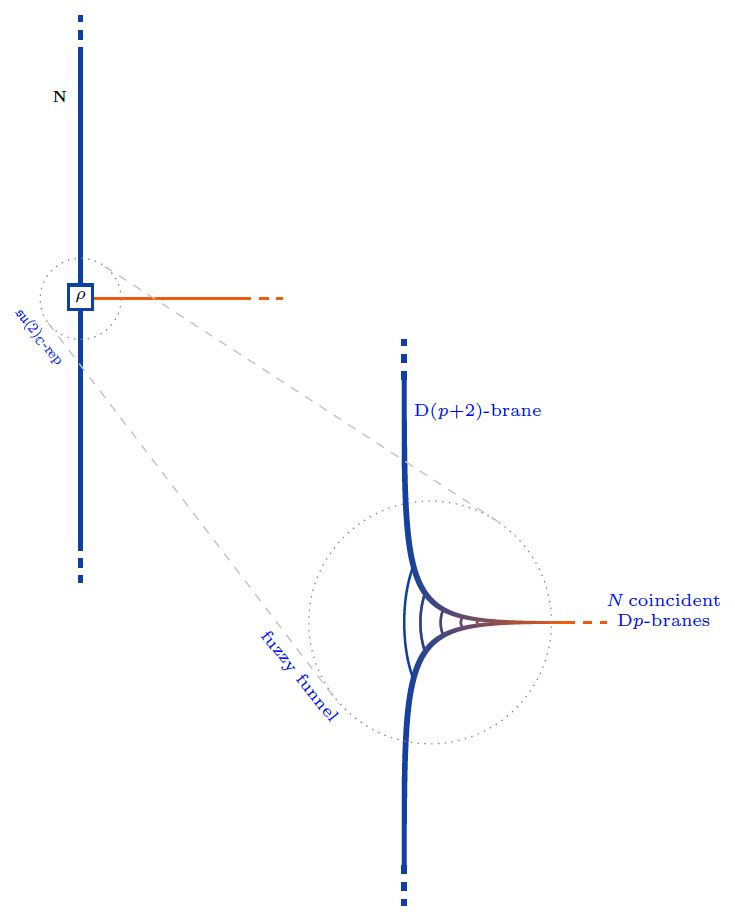
Equivalently. is an -dimensional complex Lie algebra representation of su(2). Any such is reducible as a direct sum of irreducible representations , for which there is exactly one, up to isomorphism, in each dimension :
(Here the notation follows the discussion at M2/M5-brane bound states in the BMN model, which is the M-theory lift of the present situation).
Now each irrep may be interpreted as a fuzzy 2-sphere of radius , hence as the section of a fuzzy funnel at given , whence the totality of (1) represents a system of concentric fuzzy 2-spheres/fuzzy funnels.
graphics from Sati-Schreiber 19c
Moreover, since the complexification of su(2) is the complex special linear Lie algebra (here) the solutions to the boundary conditions are also identified with finite-dimensional Lie algebra representations:
This is what many authors state, but it is not yet the full picture:
Also the worldvolume Chan-Paton gauge field component along participates in the brane intersection
its boundary condition being that
as (Constable-Myers 99, Section 3.3, Thomas-Ward 06, p. 16, Gaiotto-Witten 08, Section 3.1.1)
Together with (2) this means that the quadruple of fields constitutes a Lie algebra representation of the general linear Lie algebra
This makes little difference as far as bare Lie algebra representations are concerned, but it does make a crucial difference when these are regarded as metric Lie representations of metric Lie algebras, since admits further invariant metrics…
-brane intersections
Specifically for , i.e. for D6-D8 brane intersections, this fits with the Witten-Sakai-Sugimoto model geometrically engineering quantum chromodynamics, and then gives a geometric engineering of the Yang-Mills monopoles in actual QCD (HLPY 08, p. 16).
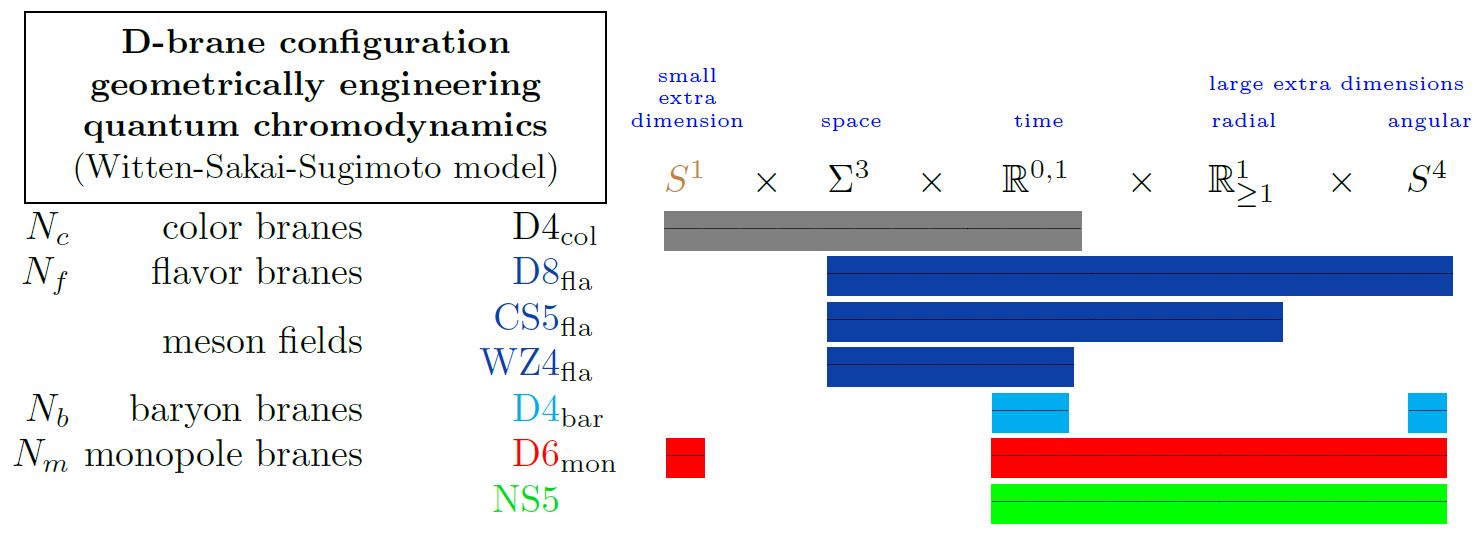
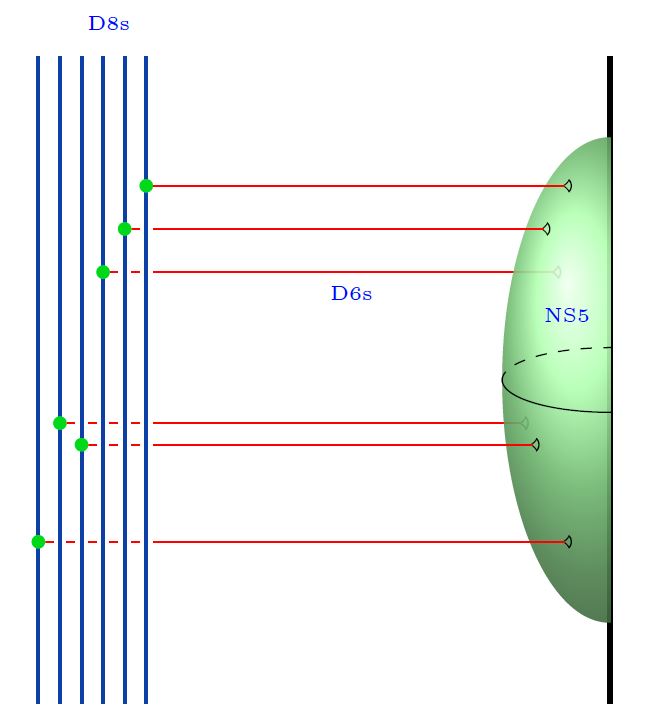
Here we are showing
-
with
-
the 5d Chern-Simons theory on their worldvolume
-
the corresponding 4d WZW model on the boundary
both exhibiting the meson fields
-
-
(see below at WSS – Baryons)
-
the Yang-Mills monopole D6-branes
(see at D6-D8-brane bound state)
-
the NS5-branes.
The s-rule
What has come to be known as the s-rule is the conjecture that the configuration of Dp-D(p+2)-brane bound states with the Dp-branes stretching from the D(p+2)-branes to NS5-branes, can be supersymmetric only if at most one D-brane ends on any one D-brane.
For D4-D6 brane intersections:
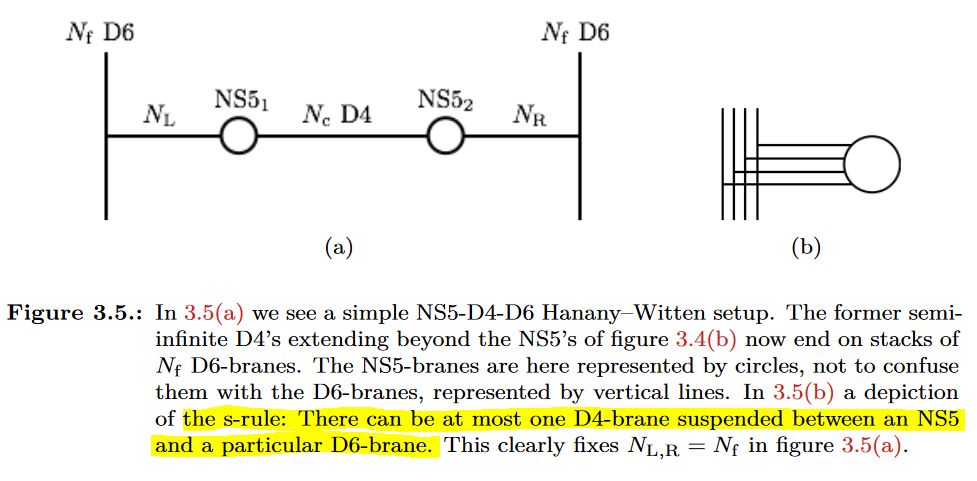
graphics grabbed from Fazzi 17
For D6-D8 brane intersections:
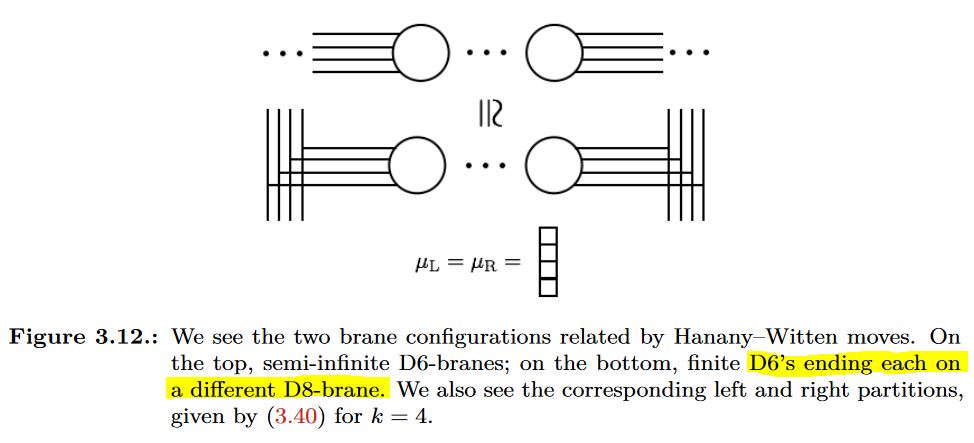
graphics grabbed from Fazzi 17
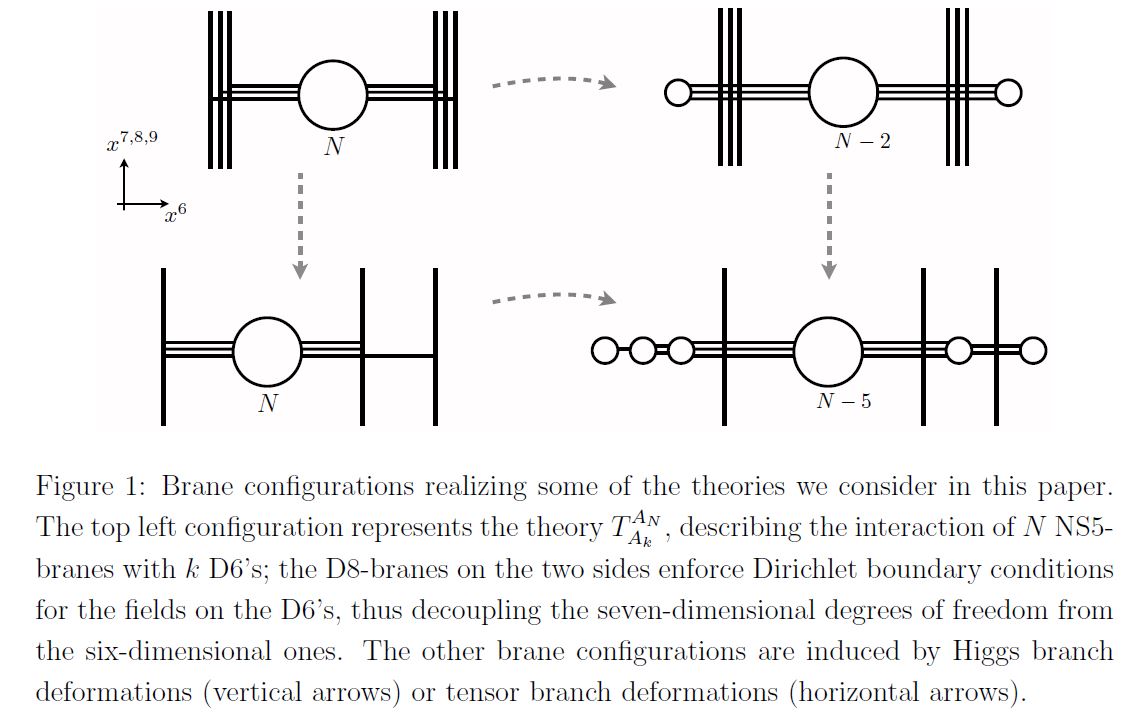
graphics grabbed from Gaiotto-Tomasiello 14
Single trace observables as -weight systems on chord diagrams
We discuss how the single trace observables on the fuzzy 2-sphere-sections of Dp-D(p+2) brane intersection fuzzy funnels are given by su(2)-Lie algebra weight systems on chord diagrams (following Ramgoolam-Spence-Thomas 04, McNamara-Papageorgakis 05, see McNamara 06, Section 4 for review).
For more see at weight systems on chord diagrams in physics.
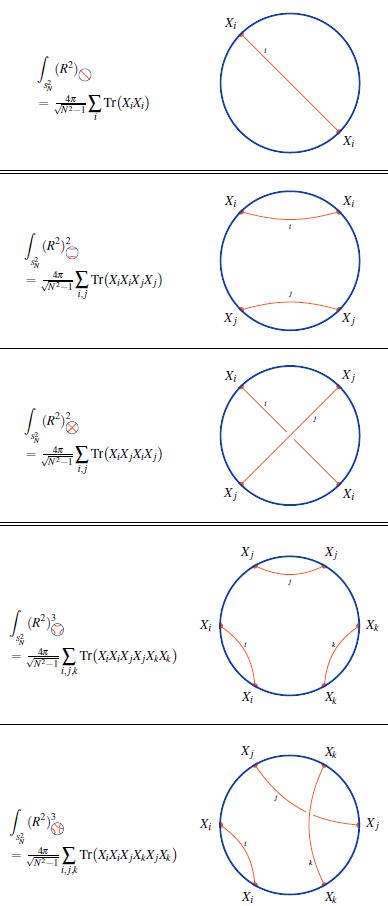
graphics from Sati-Schreiber 19c
While in the commutative large N limit, all powers of the radius function on the fuzzy 2-sphere are equal
for finite there is an ordering ambiguity: In fact, the number of functions on the fuzzy 2-sphere at finite that all go to the same function in the large N limit grows rapidly with .
At there is the single radius observable (?)
At there are, under the integral (?), two radius observables:
(Here we are using that under the integral/trace, a cyclic permutation of the factors in the integrand does not change the result).
Similarly for higher , where the number of possible orderings increases rapidly. The combinatorics that appears here is familiar in knot theory:
Every ordering of operators, up to cyclic permutation, in the single trace observable is encoded in a chord diagram and the value of the corresponding single trace observable is the value of the su(2)-Lie algebra weight system on this chord diagram.
Parallel intersection
Parallel: dissolves (Gava-Narain-Sarmadi 97)
Related concepts
brane intersections/bound states/wrapped branes/polarized branes
-
D-branes and anti D-branes form bound states by tachyon condensation, thought to imply the classification of D-brane charge by K-theory
-
intersecting D-branes/fuzzy funnels:
-
Dp-D(p+6) brane bound state
References
For parallel intersection
For parallel intersection:
- E. Gava, K.S. Narain, M.H. Sarmadi, On the Bound States of - and -Branes, Nucl. Phys. B504 (1997) 214-238 (arxiv:hep-th/9704006)
For transversal intersections
As spikes/BIons
On Dp-D(p+2) brane intersections as spikes/BIons
-
Curtis Callan, Juan Maldacena, Brane Dynamics From the Born-Infeld Action, Nucl. Phys. B513 (1998) 198-212 (arXiv:hep-th/9708147)
-
Paul Howe, Neil Lambert, Peter West, The Self-Dual String Soliton, Nucl. Phys. B515 (1998) 203-216 (arXiv:hep-th/9709014)
-
Gary Gibbons, Born-Infeld particles and Dirichlet p-branes, Nucl. Phys. B514: 603-639, 1998 (arXiv:hep-th/9709027)
from the M5-brane:
- Paul Howe, Neil Lambert, Peter West, The Self-Dual String Soliton, Nucl. Phys. B515 (1998) 203-216 (arXiv:hep-th/9709014)
As fuzzy funnels/Yang-Mills monopoles
On transversal Dp-D(p+2) brane intersections as Yang-Mills monopoles / fuzzy funnel-solutions to Nahm's equation:
For transversal D1-D3 brane intersections:
-
Duiliu-Emanuel Diaconescu, D-branes, Monopoles and Nahm Equations, Nucl. Phys. B503 (1997) 220-238 (arxiv:hep-th/9608163)
-
Amihay Hanany, Edward Witten, Type IIB Superstrings, BPS Monopoles, And Three-Dimensional Gauge Dynamics, Nucl. Phys. B492:152-190, 1997 (arxiv:hep-th/9611230)
-
Neil Constable, Robert Myers, Oyvind Tafjord, The Noncommutative Bion Core, Phys. Rev. D61 (2000) 106009 (arXiv:hep-th/9911136)
-
Robert Myers, Section 4 of: Nonabelian D-branes and Noncommutative Geometry, J. Math. Phys. 42: 2781-2797, 2001 (arXiv:hep-th/0106178)
-
Neil Constable, Neil Lambert, Calibrations, Monopoles and Fuzzy Funnels, Phys. Rev. D66 (2002) 065016 (arXiv:hep-th/0206243)
-
Jessica K. Barrett, Peter Bowcock, Using D-Strings to Describe Monopole Scattering (arxiv:hep-th/0402163)
-
Jessica K. Barrett, Peter Bowcock, Using D-Strings to Describe Monopole Scattering - Numerical Calculations (arxiv:hep-th/0512211)
-
Steven Thomas, John Ward, Electrified Fuzzy Spheres and Funnels in Curved Backgrounds, JHEP 0611:019, 2006 (arXiv:hep-th/0602071)
For transversal D2-D4-brane bound states (with an eye towards AdS/QCD):
- Alexander Gorsky, Valentin Zakharov, Ariel Zhitnitsky, On Classification of QCD defects via holography, Phys. Rev. D79:106003, 2009 (arxiv:0902.1842)
For transversal D3-D5 brane intersections:
- Davide Gaiotto, Edward Witten, Section 2.4 of: Supersymmetric Boundary Conditions in N=4 Super Yang-Mills Theory, J Stat Phys (2009) 135: 789 (arXiv:0804.2902)
For transversal D6-D8 brane intersections (with an eye towards AdS/QCD):
- Deog Ki Hong, Ki-Myeong Lee, Cheonsoo Park, Ho-Ung Yee, Section V of: Holographic Monopole Catalysis of Baryon Decay, JHEP 0808:018, 2008 (https:arXiv:0804.1326)
and as transversal D6-D8-brane bound states on a half NS5-brane in type I' string theory:
- Amihay Hanany, Alberto Zaffaroni, Monopoles in String Theory, JHEP 9912 (1999) 014 (arxiv:hep-th/9911113)
Making explicit the completion of the -representation to a -representation by adjoining the gauge field component to the scalar fields :
-
Sergey Cherkis, Instantons on Gravitons, around (21) in: Commun. Math. Phys. 306:449-483, 2011 (arXiv:1007.0044)
Relation to Vassiliev braid invariants
Relation of Dp-D(p+2)-brane bound states (hence Yang-Mills monopoles) to Vassiliev braid invariants via chord diagrams computing radii of fuzzy spheres:
-
Sanyaje Ramgoolam, Bill Spence, S. Thomas, Section 3.2 of: Resolving brane collapse with corrections in non-Abelian DBI, Nucl. Phys. B703 (2004) 236-276 (arxiv:hep-th/0405256)
-
Simon McNamara, Constantinos Papageorgakis, Sanyaje Ramgoolam, Bill Spence, Appendix A of: Finite effects on the collapse of fuzzy spheres, JHEP 0605:060, 2006 (arxiv:hep-th/0512145)
-
Simon McNamara, Section 4 of: Twistor Inspired Methods in Perturbative Field Theory and Fuzzy Funnels, 2006 (spire:1351861, pdf, pdf)
-
Constantinos Papageorgakis, p. 161-162 of: On matrix D-brane dynamics and fuzzy spheres, 2006 (pdf)
Lift to M2-M5-brane bound states
The lift of Dp-D(p+2)-brane bound states in string theory to M2-M5-brane bound states/E-strings in M-theory, under duality between M-theory and type IIA string theory+T-duality, via generalization of Nahm's equation (this eventually motivated the BLG-model/ABJM model):
-
Anirban Basu, Jeffrey Harvey, The M2-M5 Brane System and a Generalized Nahm’s Equation, Nucl.Phys. B713 (2005) 136-150 (arXiv:hep-th/0412310)
-
Jonathan Bagger, Neil Lambert, Sunil Mukhi, Constantinos Papageorgakis, Section 2.2.1 of Multiple Membranes in M-theory, Physics Reports, Volume 527, Issue 1, 1 June 2013, Pages 1-100 (arXiv:1203.3546, doi:10.1016/j.physrep.2013.01.006)
Single trace observables as weight systems on chord duagrams
Relation of single trace observables in the non-abelian DBI action on Dp-D(p+2)-brane bound states (hence Yang-Mills monopoles) to su(2)-Lie algebra weight systems on chord diagrams computing radii averages of fuzzy spheres:
-
Sanyaje Ramgoolam, Bill Spence, S. Thomas, Section 3.2 of: Resolving brane collapse with corrections in non-Abelian DBI, Nucl. Phys. B703 (2004) 236-276 (arxiv:hep-th/0405256)
-
Simon McNamara, Constantinos Papageorgakis, Sanyaje Ramgoolam, Bill Spence, Appendix A of: Finite effects on the collapse of fuzzy spheres, JHEP 0605:060, 2006 (arxiv:hep-th/0512145)
-
Simon McNamara, Section 4 of: Twistor Inspired Methods in Perturbative FieldTheory and Fuzzy Funnels, 2006 (spire:1351861, pdf, pdf)
-
Constantinos Papageorgakis, p. 161-162 of: On matrix D-brane dynamics and fuzzy spheres, 2006 (pdf)
In solid state physics
Relation of Yang-Mills monopoles as Dp/D(p+2)-brane intersections and Yang-Mills instantons as Dp/D(p+4)-brane intersections to the K-theory classification of topological phases of matter via AdS/CFT duality in solid state physics:
- Koji Hashimoto, Taro Kimura, Band spectrum is D-brane, Progress of Theoretical and Experimental Physics, Volume 2016, Issue 1 (arXiv:1509.04676)
Last revised on February 12, 2020 at 12:17:07. See the history of this page for a list of all contributions to it.